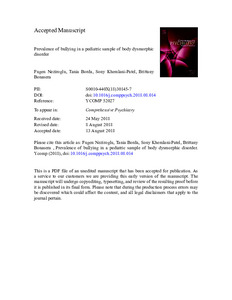Por favor, use este identificador para citar o enlazar este ítem:
https://repositorio.uca.edu.ar/handle/123456789/9540| Título: | Prevalence of bullying in a pediatric sample of body dysmorphic disorder | Autor: | Neziroglu, Fugen Borda, Tania Khemlani Patel, Sony Bonasera, Brittany |
Palabras clave: | BULLYING; TRASTORNO OBSESIVO COMPULSIVO; TRASTORNO DISMORFICO CORPORAL; PSICOPATOLOGIAS | Fecha de publicación: | 2018 | Editorial: | Elsevier | Cita: | Neziroglu, F. et al. Prevalence of bullying in a pediatric sample of body dysmorphic disorder [en línea]. Comprehensive Psychiatry. 2018, 87. doi:10.1016/j.comppsych.2018.08.014 Disponible en: https://repositorio.uca.edu.ar/handle/123456789/9540 | Resumen: | Abstract: Little is known about etiological factors in Body dysmorphic disorder (BDD). Cognitive behavioral and diathesis-stress models have implicated teasing and bullying as significant early environmental stressful triggers. Due to these implications, this study aimed to assess the emergence of BDD in children during early development, and to see if bullying experiences played a role in its development. A total of 219 children ages 7 to 10 were screened for psychopathology. Children were separated into four groups including a BDD group, an OCD group, a clinical control group (consisting of depressive disorders, attention deficit hyperactivity disorder, oppositional defiant disorder, and anxiety disorders not otherwise specified), and a non-clinical control group. Children were given questionnaires to evaluate their bullying and victimization experiences. It was hypothesized that children with BDD would experience more instances of victimization than children with OCD, clinical controls, and non-clinical controls. Contrary to the hypothesis, results indicated that children with BDD symptoms were significantly more likely to be perpetrators of bullying than the other groups [F (3, 27.082) = 17.892, p < .001]. In addition to scoring high on the bullying questionnaires, children with BDD scored high on victim questionnaires as well, suggesting a link between these two peer interpersonal conflicts. The results of this study suggest that bullying behavior might be an unknown characteristic in young children with emerging BDD pathology. | URI: | https://repositorio.uca.edu.ar/handle/123456789/9540 | ISSN: | 0010-440X (impreso) 1532-8384 (online) |
Disciplina: | PSICOLOGIA | DOI: | 10.1016/j.comppsych.2018.08.014 | Derechos: | Acceso abierto | Fuente: | Comprehensive Psychiatry. 2018, 87 |
| Aparece en las colecciones: | Artículos |
Ficheros en este ítem:
| Fichero | Descripción | Tamaño | Formato | |
|---|---|---|---|---|
| prevalence-bullying-pediatric-sample.pdf | 620,67 kB | Adobe PDF |  Visualizar/Abrir |
Este ítem está sujeto a una Licencia Creative Commons

